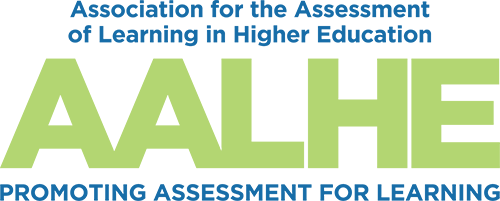- Home
- About AALHE
- Board of Directors
- Committees
- Guiding Documents
- Legal Information
- Organizational Chart
- Our Institutional Partners
- Membership Benefits
- Member Spotlight
- Contact Us
- Member Home
- Symposium
- Annual Conference
- Resources
- Publications
- Donate
EMERGING DIALOGUES IN ASSESSMENTInching Together: Making Significant and Sustained Growth through Cooperation
March 12, 2020 Glenn Allen Phillips, Ph.D. and Rebecca D. Graham, Ph.D.Being an assessment professional responsible for institution-wide assessment can be rather lonely, particularly in a one- or two-person office. Though there is often constant communication with faculty and staff across the institution, it is rare that all campus practitioners speak the same language of assessment or engage in mirrored practices. This article traces the professional connection that we, two assessment officers from different universities, made and explores how our ability to dialogue and collaborate with each other has led to improved outcomes and a better work environment. Rebecca’s Perspective About a year ago, I was working with a student affairs colleague at the University of the District of Columbia (UDC) on a survey for students newly matriculating at our university. We were mulling over the wording on some of the survey’s demographic questions when I suggested that we ask colleagues on the ASSESS listserv to help us think about our specific identity-based questions in the survey’s design. (AALHE’s ASSESS listserv is a community of assessment professionals who regularly exchange ideas, tips, and, in some cases, advice. See more here: https://www.aalhe.org/assess-listserv.) When I received a direct response from Glenn, who is the director of assessment at Howard University, I seized the opportunity to ask if he wanted to meet up and talk about all things assessment. I was new to my role, and as two directors of assessment at Historically Black Colleges and Universities (HBCUs) in Washington, D.C., I could only see benefits from forming such a relationship. As is often the case for assessment professionals, I was feeling a little alone. During our meetings and subsequent phone calls, we have found some serendipity. Howard’s immediate assessment activities (revision of course evaluations, bottom-up assessment, assessment of non-instructional units, and effective use of assessment platforms) mirrored activities that UDC was aiming to prioritize. At the same time, immediate assessment activities at UDC (general education assessment, rubric development and calibration, unit-level reporting, and faculty development) were on Howard’s list of priorities as well. Throughout our conversations, we discussed and shared our institutions’ assessment practices and how they may (or may not) translate to our respective campuses. At one point, Glenn and I talked about moving things forward in “inches.” We had large assessment goals in our respective offices that stretched out over yards or miles, but some days it felt like we progressed on those goals only by a couple of inches. We decided that inching is still progress, however, and that we could frame our new collegiality as inching together. Glenn’s Perspective I read Rebecca’s question on the ASSESS listserv. New to my geographic region, Howard University, and the director position, I had not yet identified peers that I could grow alongside in my field. I had yet to hire the assistant director my office had budgeted, and my predecessor did not wish to be contacted. My two mentors, both assessment administrators at large universities in the South, were always happy to chat but often running the complex responsibilities of their own offices and wholly unaware of the context in which I was working. For the first time in my professional life, I felt a little alone. When I answered Rebecca’s question, I was not answering with definitional authority. Instead, I was suggesting one possibility. Often the field of assessment depends as much on the person defining its terms and policies as it does the institution, administration, institutional type, and accrediting region. While some sacred texts offer general rules and practices that govern assessment, assessment tends to be a very personal thing, sensitive to the particularities of the people and the programs it assesses. Best practices are often a misnomer as “best” can often ignore context, political climate, leadership, and resources. Therefore, the best we can do as peers and colleagues is make suggestions and hope that these can spark ideas or spur activities that the listener or reader will find helpful. Rebecca appreciated my suggestions, and we immediately scheduled a visit. The next week Rebecca drove west to see our office and chat for an hour about the culture of assessment at both Howard University and UDC. This visit sparked a standing, monthly phone call during which we discuss assessment activities at our institutions. These phone calls have been both enjoyable and productive. Recommendations to Others Reflecting on the benefits of our monthly interactions, we would like to offer some advice to assessment professionals on how to identify partners to “inch” with—and some potential frameworks for inching. Please note that these are just suggestions, and the details of your own needs, institutions, work-flow, and even personalities may contradict some of this advice. When choosing a partner to inch with, consider identifying an institution that shares some common trait(s) with your institution. For example, locating a college or university in your geographical area would be most beneficial—for two reasons. First, you may want to visit your partnering institution to see how things work there or to partake in an activity. UDC invited Howard assessment folks to participate in a rubric calibration session, which would not have been easy if we lived far from one another. Similarly, Howard traveled to UDC to suggest some helpful practices on integrating UDC’s new survey platform across various campus units, which is also used at Howard. Secondly, partnering with a neighbor will often mean that you share a regional accreditor. Accreditors are different, and navigating their processes and expectations can be easier when it is done alongside a peer. Next, it is helpful to select a partner who is in a similar role. While assessment offices may differ from one university to the next, and a director at one institution may be called a coordinator at another, partnering with someone at the same hierarchical level and with the same responsibilities will help ensure that there is plenty of relatable, common ground to discuss. If a director tries to “inch” with an associate provost, the magnitude of the associate provost’s portfolio and the particular concern the director has with process may make it challenging to identify topics of conversation. “Partnering on the vertical,” or connecting with people above or below you in rank, can also result in a deference to authority that may undermine the “inching together” idea. Inching together is based on partnerships, and these partnerships include some interpersonal development. Partnerships should be formed with people who are ready to learn but who are also prepared to teach. After you have identified a person to inch with, it is essential to agree on the details of how to inch together, which will include a set of ground rules for the partnership—our ground rules include mutual trust, respect, honesty, empathy, and openness. As part of our commitment to honesty, we knew that if we were not willing to share some of the challenges of our jobs, then we might not be able to inch forward together effectively. Functionally, it also helps to identify clear logistics with “inching” partners. We decided to phone one another once a month. A monthly meeting makes the conversation productive but not burdensome. Additionally, the monthly time period provides both parties the opportunity to look back at what was discussed the previous month, provide updates, and give advice on what has changed or what new initiative is being planned. The steady cycle of debriefing and reflecting gives assessment professionals a necessary sounding board, particularly when they are the only (or one of the only) assessment staff at their institution. Assessment practitioners who wish to find others to inch with have a variety of avenues to pursue. While we met through a listserv discussion, we have met other professionals in our networks through conferences, research follow-up, and “cold calls.” Conferences offer ways to build both regional and discipline-specific alliances, and assessment publications offer lists of practitioners who are asking important questions and offering their best answers. Finally, assessment professionals can find fellow inchers by contacting the assessment offices of nearby institutions. A “cold call” may indeed lead to warm collegiality. Professional organizations have long recognized and shown the value of cross-institutional collaboration; however, rarely do we take the time to establish these relationships. Making intentional partnerships with individuals outside of our institutions can contribute to sustained and productive growth for all parties. Though assessment professionals may be progressing by inches at their respective institutions, they will, at least, be inching together. |

